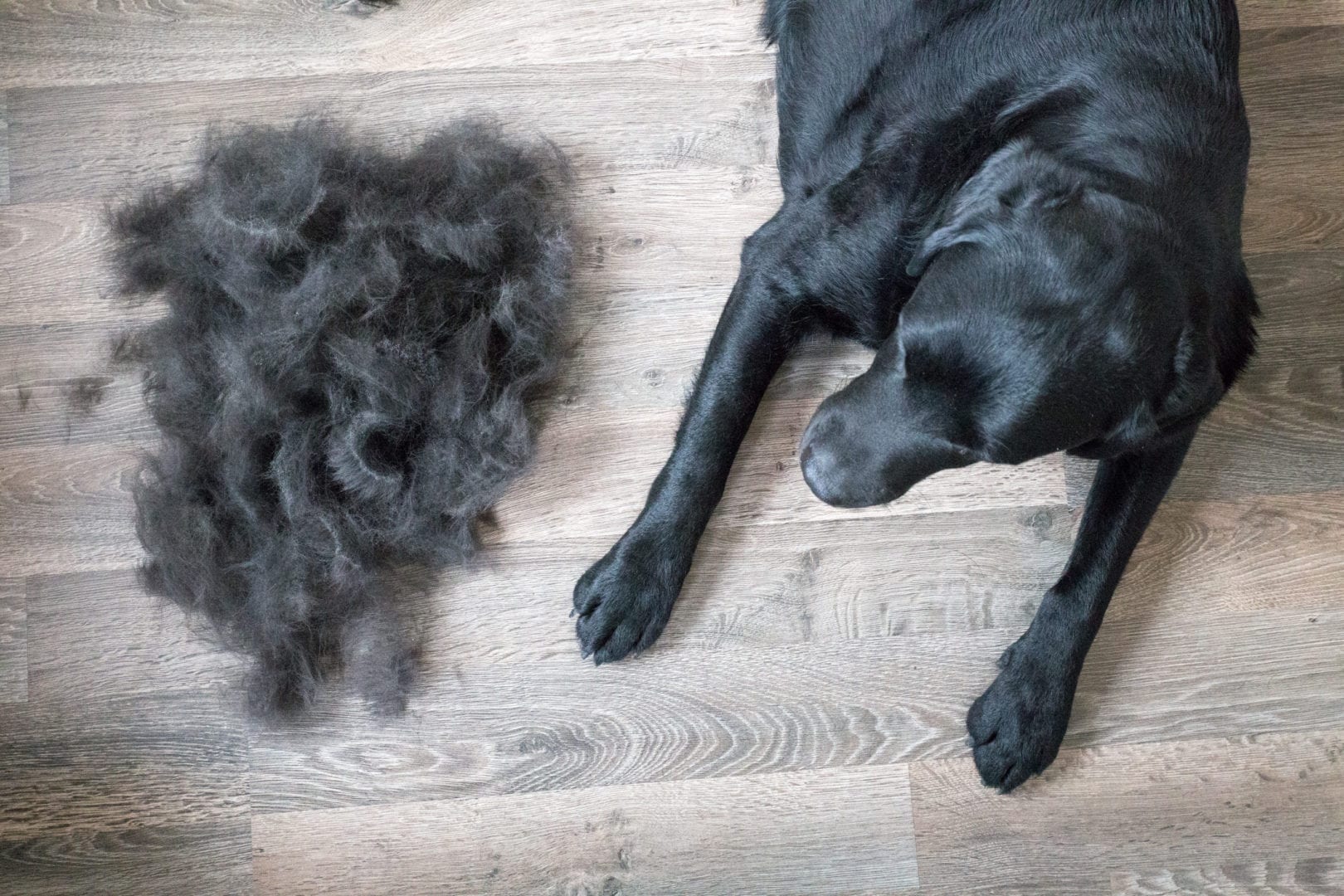Your dog’s hair is falling out. And not just a little bit — we’re talking tufts of hair rolling down your hallway like tumbleweed in the Wild West. But before you start freaking out, here’s some information about dog hair loss that you need to know.
“Some breeds are naturally going to shed a whole bunch and some breeds aren’t going to shed very much at all,” says Dr. Chris Reeder, a veterinarian at BluePearl Veterinary Partners in Nashville, Tennessee, who is board-certified in dermatology. “You have to look at what kind of breed of dog you have and if it’s normal and natural for them to shed a lot, versus the dogs that don’t normally shed a whole lot.”
First step, research your breed and determine whether regular shedding is a common occurrence for them.
“If a person has a Labrador retriever and it’s shedding a lot but there’s no actual alopecia, there’s no bare spots, there’s no baldness on the dog, then it’s usually not a problem,” Reeder says. “Just about every breed’s going to go through bigger cycles, one or two times a year anyway. That’s something that’s a natural phenomenon.”
What’s not natural is bald spots on your dog’s body.
“[If] there’s some degree of alopecia (a.k.a. baldness) and that’s the concern,” he says. “That’s when owners may want to investigate it a little further.”
Hair loss around the eyes or on the trunk of the body, or extreme hair thinning where you can almost see the skin or there is no hair at all, would all be something to investigate the cause of, according to Reeder, so schedule a vet visit. But Before you go, note your dog’s symptoms.
“There are two main categories of hair loss: itchy and non-itchy,” Reeder says. “If the dog’s scratching, licking, chewing, biting, rubbing, rolling, any of those things, and the hair’s coming out because of [this behavior], that’s different than the hair falling out and the dog doesn’t seem bothered by it. It’s not itchy, it’s not scratching, it’s not having a problem. So we try to classify that from the owner.”
There are a lot of reasons that dogs lose their hair and Reeder divides them into seven major categories. Take a look at the causes and find out how your vet can help.
Nutritional hair loss in dogs
“Dogs can lose hair when they’re not receiving proper nutrition.
“There’s a lot of [owners] who are really interested in home cooking diets, and that’s one of those that I would be cautious about,” Reeder says. “To make sure that the diet is well-balanced.”
If it’s a commercial food, most of the time it will be balanced, Reeder says, but if you’re making it yourself you’ll need to make sure it’s packed with what your dogs needs to stay healthy.
“So many people are making their own diet, this can be an issue for some cases,” he says.
Treatment: Usually your vet will investigate other causes first, Reeder says, and check a dog’s body condition score (the equivalent of the BMI for humans) and ask questions about your dog’s meals. If a nutritional imbalance is determined to be the cause, you’d need to work with your vet on changing the diet.
Hormonal hair loss in dogs
“There’s a ton of different hormonal reasons for why dogs lose their hair,” Reeder says, adding that with hormonal hair loss, it’s typically very symmetrical and usually affects the trunk of the dog.
One of the most common causes of hormonal hair loss is Hypothyroidism or a low thyroid.
“I feel like [it’s] over-diagnosed, but it certainly causes hair loss,” he says.
Additionally, Cushing’s disease or atypical Cushing’s disease are other common causes.
“That’s an overproduction of hormones,” he says. “So you’ve got too much of these hormones produced by the adrenal gland that cause suppression of the hair growth, then we get hair loss.”
Treatment: If hormonal production is too low, your veterinarian will prescribe thyroid supplementation. If it’s too high, medications that will reduce hormone production will be prescribed.
“Lots of things affect the thyroid, so that’s where testing would have to be done by the veterinarian,” he says.
Allergic hair loss in dogs
There are three types of allergies that are most common, according to Reeder, environmental or what they atopy — meaning something they’re allergic to in the environment — and then flea allergy and food allergy.
“Any of those can create traumatic hair loss, meaning the dog’s itchy, scratchy, they’re going to have symptoms of being allergic, other than hair loss,” he says. “[Symptoms include] scratching, in some of these cases you may or may not see fleas. They’ll be really itchy.”
Allergic hair loss is not typically symmetrical, he adds.
Treatment: For environmental allergies there are many types of treatment options.
“There’s medications (and) there’s supplements,” he says. “What we do in our practice, we do allergy testing and we provide custom allergy serum or shots for dogs. There’s also a liquid oral formulation. Just like for people, same test, same stuff.”
Getting to the bottom of food allergies isn’t easy and involves working with your veterinarian to determine what foods your dog is allergic to and “getting on the right diet that doesn’t contain the offending ingredient,” he says. The treatment for a flea allergy is flea control — some of those are over the counter, some are prescribed.
Hair loss with infection
Examples of this are bacterial or yeast infections and also ringworm, which is a fungal skin infection. Bacterial or yeast infections are “usually secondary to some underlying cause,” Reeder says. “Occasionally you can have more than one cause for the hair loss and so a lot of times those can be piggybacked onto parasitic infections, hormonal imbalances or these allergic conditions. Those can be a secondary complicating factor with those other things that are going on and they make it even worse.”
Treatment: Your vet will treat bacterial or yeast infections with antibiotics. For ringworm, an antifungal like a topical cream or ointment is used.
Parasitic hair loss
This type of hair loss can be caused by mange, a skin disease involving parasitic mites. There are two common types, demodectic mange, which cannot be transmitted to people, and sarcoptic mange a.k.a. scabies, which can be transmitted to people.
“Demodex mites live in the hair follicles, because of where they live, the hair falls out,” Reeder says. “Sarcoptic tends to be very itchy, the hair loss results in the fact that the scabies mites kind of live in these tunnels under the upper layers of the skin.”
Treatment: These conditions cause unsightly scabbing and sores that can be easily treated with common flea and tick preventatives.
“They absolutely treat either one of those,” Reeder says.
Hair loss due to cancer
One of the more common kinds of cancer veterinarians see, Reeder says, is cutaneous lymphoma and that’s diagnosed through a biopsy during a veterinary visit.
“The other one we see is metastatic cancer, sometimes we call that paraneoplastic, where you’ve got something internal and it happens to manifest on the skin and that can cause the hair to be lost as well,” he says.
Treatment: The treatment for both cancers are medication and chemotherapy.
“Most of the time that’s going to be the case,” he says. “Let’s say the dog has an adrenal tumor that can be taken out, that can be curative but usually cancer is not a curative thing.”
Other miscellaneous causes
1. Sebaceous Adenitis
This is an inflammatory skin disease that can cause hair loss.
“It’s most common in poodles, standard poodles and Akitas,” he says. “However, it can be seen in any breed. You see a lot of hair loss with this condition.”
Treatment: Sebaceous Adenitis is diagnosed through skin biopsies and most commonly medication is used to treat it, but Reeder adds that sometimes topical therapies are also used.
2. Seasonal Flank Alopecia
This is the seasonal loss of hair for some dogs.
“We see this very commonly in English bulldogs, airedales, we see it sometimes in French bulldogs,” he says. “This has a very classic saddle appearance, over their back, on the flanks of their skin there’s hair loss and usually it’s very smooth, it’s darkly pigmented and they’re not itchy most of the time.”
Treatment: “Treatment for that is don’t do anything at all or sometimes melatonin is used after a conversation with your veterinarian,” he says. “They’re doing micro-needling in Europe a little bit right now, using that to get the hair to come back and grow.”
3. Color Dilution Alopecia
This is a genetic inherited condition “that is seen most commonly in the silver Labs, blue Dobermans,” Reeder says. “It’s a genetic issue. The coat color gene is abnormal or mutated” causing hair loss.
Treatment: There is no treatment for this condition.
“Most of the time diagnosis is just by the sight of it, sometimes we can diagnose it in the clinic through hair samples or through biopsies,” he says. “The biggest thing here is not to use harsh shampoos and avoid excessive brushing and grooming because the hairs fracture and come out real easily.”

